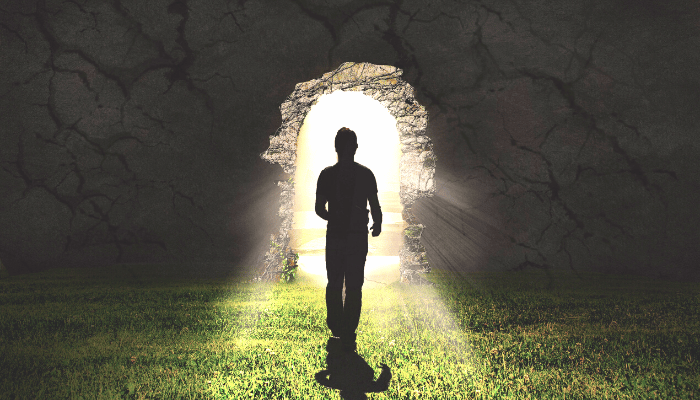Our brains are wired to become overactive in troubled times, and we are wired evolutionarily to look for the negative. This “negativity bias,” after all, was a very effective survival tool. If you are vigilant ancient man on guard for a human or animal predator, you are more likely to notice it and escape. Just think—all of our ancestors were really good at thinking about and preparing for the worst-case scenario; if they weren’t, we wouldn’t be here today.
But there is good news when it comes to how to effectively push back on anxious and negative thoughts. Raising the I, for Intellectual, in WBI’s SPIRE model of well-being—which we can also think of as curiosity—can help with managing anxious thoughts.
Here is the analogy as presented by Steven Hayes of the University of Nevada’s Department of Psychology. Pretend that you are in an anxious state. Think of this condition as having a number on a dial or knob, as you might find on a stereo. Pretend your anxiety level fluctuates between a 5 and a 9 out of 10 on most days. Even if you work really hard at reducing your anxiety, perhaps through a progressive relaxation meditation or walking outside or talking with a friend, this may not be enough. You feel better for a short time as you notice lower numbers. Then, all it takes is switching on the news, participating in a different conversation, or reading a troubling Facebook post, email, or text, and up goes your anxiety by a few points. You have undone all of your good calming work!
Now, imagine, instead of directly targeting your “anxiety knob,” you realize that you have a second, hidden knob. This knob is called the “curiosity knob” or the “explorer knob.” Just like the anxiety knob, it can go from zero to 10. All along, you may have been focusing your attention on dialing your anxiety knob lower using coping strategies that may or may not work. Try this new strategy: Leave your anxiety knob alone and turn your attention elsewhere by turning up the “curious explorer” knob.
How do you move up “curious explorer?” Perhaps you decide to invest in an activity that you have never participated in before, like a dance class, or an online course, or a mountain biking group. You fully engage in these activities and—wow—you notice that turning up the curious explorer helps to turn down anxiety. Here you are targeting anxiety, but through a different path.
To illustrate, think of a recent time when you purposefully engaged in a fairly novel and enjoyable activity, and you realized that your stress was lower and your happiness higher. By taking your mind off your worries through actively participating in a mindful activity, you indirectly dialed down your stress level.
Mindfulness and anxiety cannot reside in the same place at the same time. Turn up curiosity to turn down anxiety. I found this idea not only intriguing but brilliant. After all, curiosity was what first led me to positive psychology, and gave me a whole new set of tools to use as a health coach. So, I decided to try this sage advice myself by purposefully engaging in new activities on a regular basis. I subscribed to an online fitness platform, and have been participating in dance classes a few times weekly. (Look out, Missy Elliott!) Anxiety down, happiness up!
Next, I joined a friend on a hike up on Mount Washington here in Pittsburgh—an evening hike through the forest, overlooking the highways below, to watch the moon rise. We had headlamps and everything! Amazing! Curiosity was definitely up! My well-being was lifted that night and for many days after.
Next, I accepted an invitation to participate in a forest bathing activity, which is essentially practicing mindfulness in nature. During this experience, we were invited to pay attention with all of our senses to the world around us. We noticed the sights and sounds of animals and insects scurrying around us, and the soft sound of the flowing water. I felt peaceful and uplifted afterward.
So, in my opinion and experience, raising curiosity definitely works as a tool to reduce anxiety and raise happiness levels. Maybe you’ll take some of my suggestions, or discover your own, rotating in unfamiliar experiences regularly. The brain loves novelty! In her book The How of Happiness, Sonya Lyubomirsky reminds us that while one happiness activity may delight you right now, it may not have the same effect next month. So try new things, and try them often.
Curious about how to integrate positive psychology into your coaching practice? Learn more about Sandy’s WBI course, Introduction to Wholebeing Happiness for Coaches. This interactive 5-week online course will give you the science, skills, and practical handouts to assist your coaching clients on their journey towards greater happiness and optimal well-being.

Sandy Campbell
Sandy Campbell, a 2018 CiWPP graduate, is a Health and Wellness Coach, and holds an MS in Counseling from Villanova University, a degree from the Institute of Integrative Nutrition, and a 200-hour yoga teacher training certification. After working for 10-plus years for a major pharmaceutical company, Sandy decided to step out of the corporate world and focus on improving her health, quality of life, and happiness. Her passion evolved into helping others meet their full potential through small but highly impactful dietary and lifestyle shifts. Focusing on nutrition, stress management, and positive psychology, Sandy works with clients in person and remotely; leads corporate wellness workshops for businesses and organizations, including the Federal Home Loan Bank of Pittsburgh, Mylan Pharmaceuticals, and the Community College of Allegheny County; and leads on-site and online programs, including her 11-Day Pure Energy Program, a clean eating boot camp. Learn more at sandycampbell.net or on Facebook at Sandy Campbell Wellness.


